Located on the Asian side of the city, Kadıköy hums with a different rhythm than the tourist-heavy historic core. This is where young artists gather over tea in tucked-away courtyards, where cafés double as record shops, and where political posters layer the walls beneath sprawling murals. It’s gritty, warm, energetic, and deeply alive.
Long known for its progressive politics and artistic pulse, Kadıköy has become a haven for Istanbulites seeking something a little more local, a little more expressive, and a little less polished. It’s also one of the most compelling places in the city to base yourself—especially if you’re a digital nomad or traveler craving a slower, more community-oriented kind of city life.
In this guide, we’ll take you through what makes Kadıköy so distinct—from its creative enclaves and café culture to its bold murals, markets, and moments of quiet tenderness.
A local alternative to the tourist circuit
Across the Bosphorus from the heavyweights of Sultanahmet, Kadıköy offers a different kind of Istanbul. It’s not defined by minarets or must-see monuments. Instead, the neighborhood pulses with lived-in energy—a tangle of sidewalk cafes, vinyl shops, vintage bookstores, and alleyways laced with graffiti. It’s where young Istanbulites come to think, create, protest, sip, smoke, and flirt. And increasingly, it’s where slow travelers and digital nomads go to live, rather than just visit.
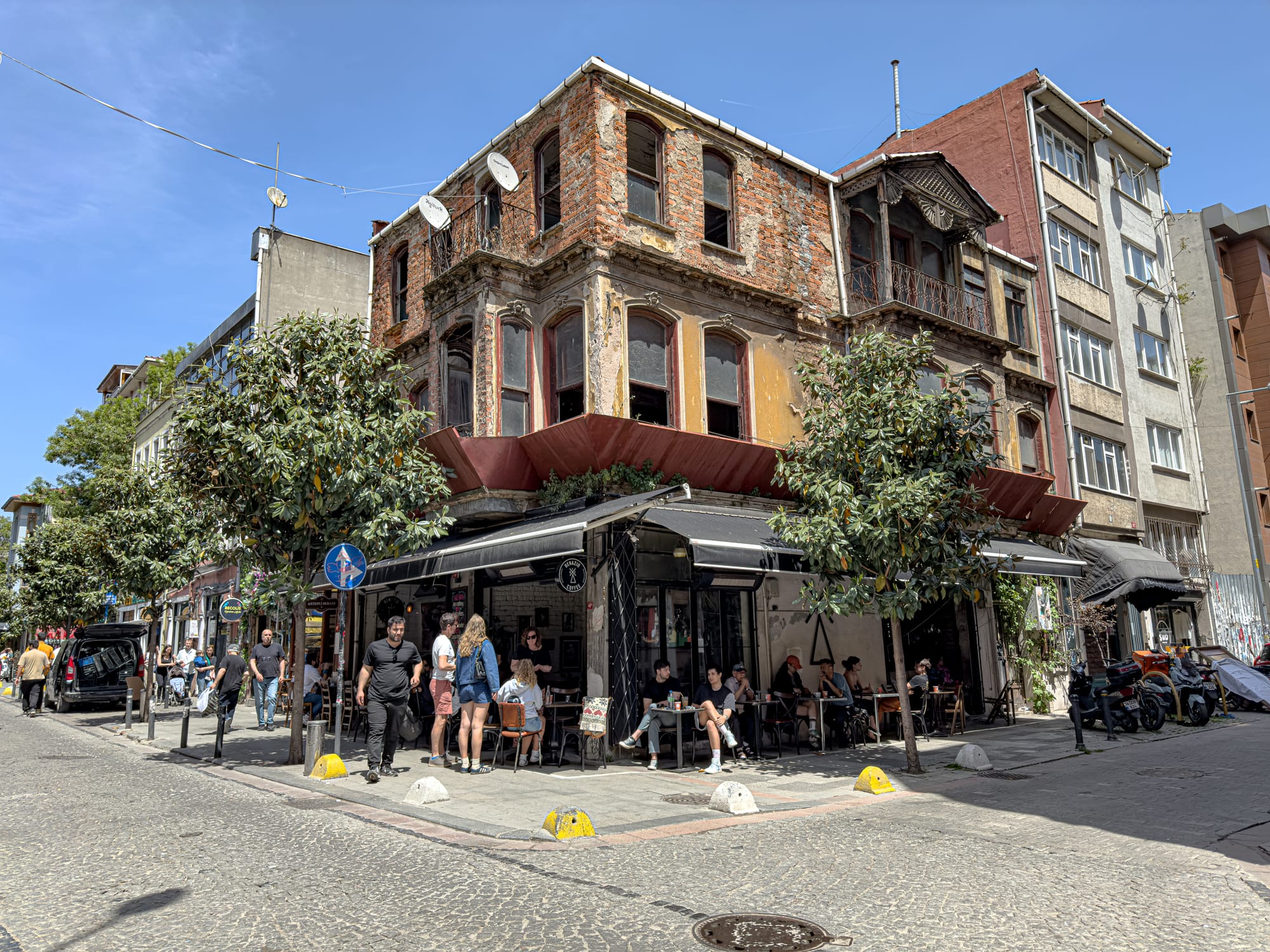
While Kadıköy is firmly rooted in its own history—one shaped by working-class life, labor movements, multicultural households, and political unrest—it’s now one of the city’s most progressive districts. You’ll find LGBTQ+ spaces, leftist bookstores, gender-inclusive bathrooms, radical art collectives, and late-night record spinning, all within a few blocks of each other.
Staying in Kadıköy as a digital nomad
Kadıköy makes an especially compelling base for digital nomads—particularly those who’d rather trade quick sightseeing for a deeper rhythm of life. While it’s a ferry ride away from tourist staples like the Hagia Sophia or the Grand Bazaar, the tradeoff is a far more grounded and local Istanbul experience.
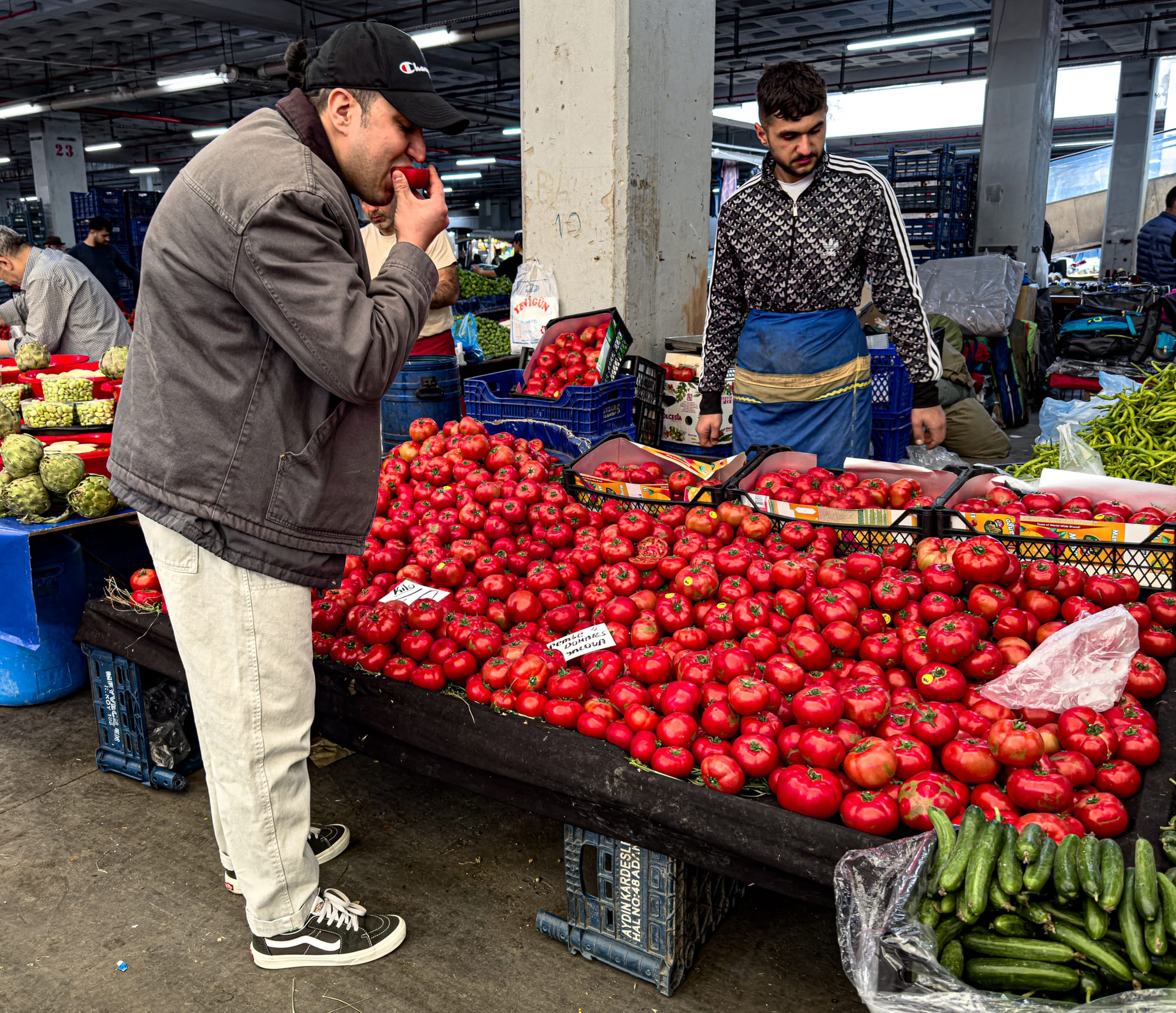
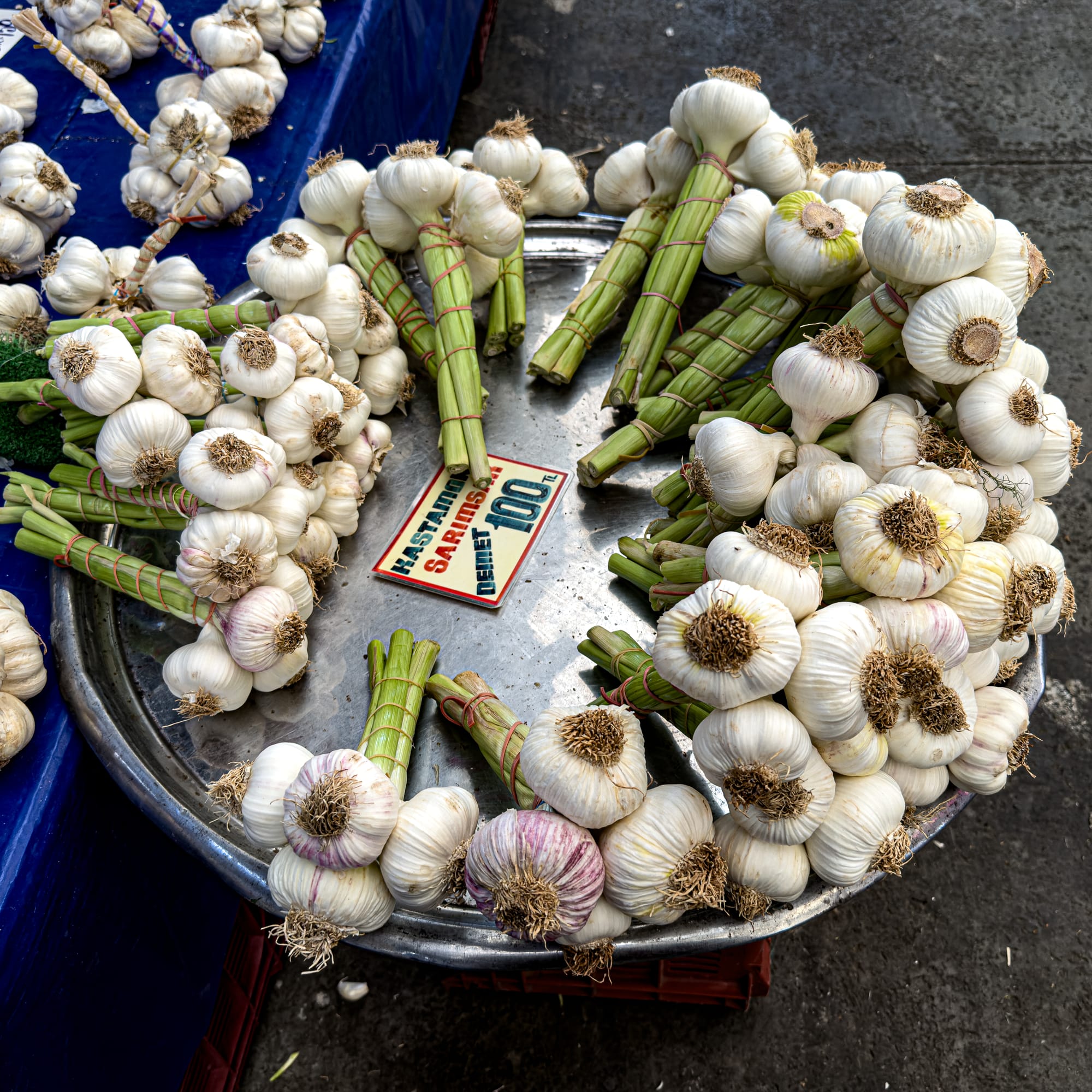
Scenes from the Kadıköy's Tuesday and Friday Bazaar: tomatoes worth biting into, and local garlic
Cafés here double as co-working spaces, and you’ll never run out of third-wave coffee or simit. There’s also Nest Digital Nomad House, a coliving space just off one of the neighborhood’s quieter streets. While we didn’t stay there ourselves, it seems to host a like-minded and curious community—ideal for those looking to plug into both work and the creative pulse of the area.
A bonus of staying in Kadıköy is also proximity to the Tuesday and Friday Bazaar, a great place to buy fruit and veg.
Scenes of the neighborhood
The café culture here is thick: students reading novels over cold brew, artists sketching, and small groups plotting magazine collectives. It’s not rare to spot political stickers, mural stencils, or even impromptu zines stacked near the sugar jar.
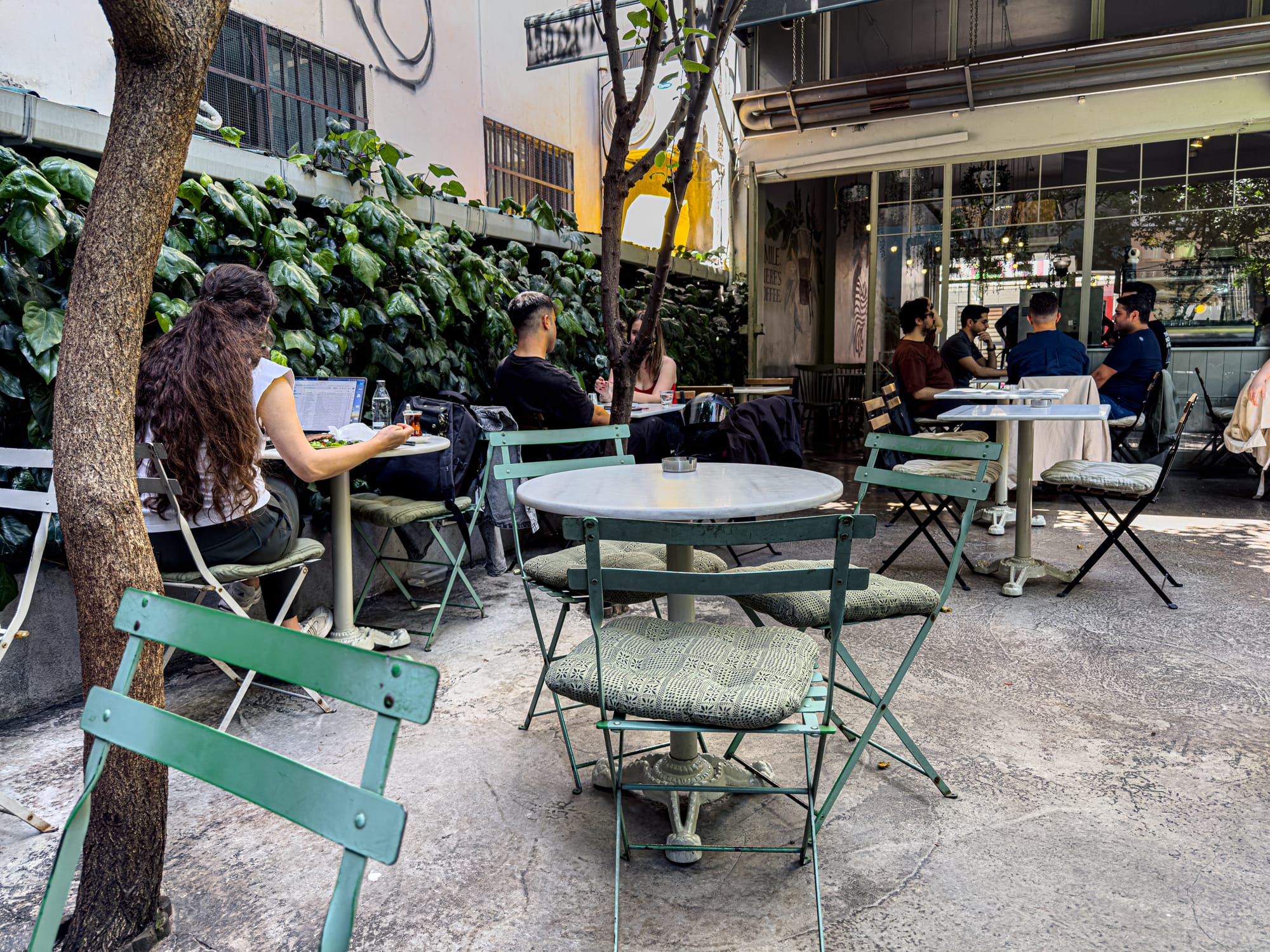
Kadıköy's charm isn’t structured around museums or monuments, but in the intervals between things—the corner where a saxophonist plays to no one in particular, the alley where someone’s drying herbs on a clothesline, the back table at a cafe where a poetry zine is being laid out.
One of the first things you’ll notice is the abundance of seating—but not just for customers. Plastic stools spill into the streets from tea shops, bench-lined courtyards host spontaneous sketch sessions, and concrete planters double as makeshift lounges for cigarette breaks and street-side arguments. It’s a neighborhood that invites pause, not just consumption.
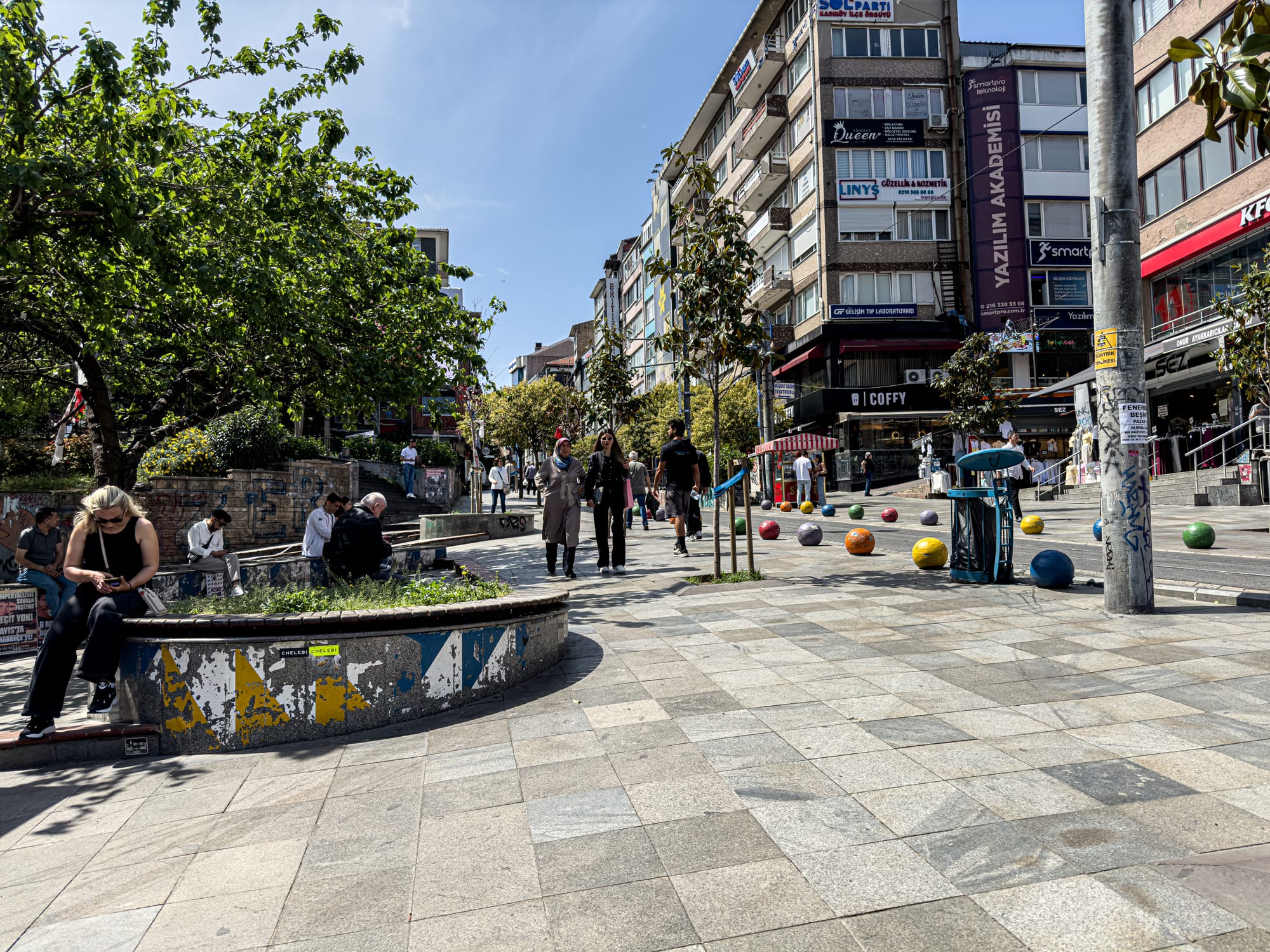
There’s a textured visual noise here: pastel buildings with peeling paint, overgrown potted plants balanced on windowsills, layers of stickers on every pole and trash bin. Some corners are pristine and curated—especially near third-wave cafes and boutique bookstores—while others are gloriously chaotic: graffiti-tagged staircases, overflowing dumpsters, political posters half-peeled by rain.
Art everywhere
While our Kadıköy street art post goes deep into the mural scene, it’s worth repeating here: art in Kadıköy isn’t limited to galleries. It leaks into everything—onto trash bins and electricity boxes, across the sides of grocery stalls and rooftops, scrawled along handrails, splashed across staircases. In Kadıköy, art isn’t an institution; it’s an ecosystem.
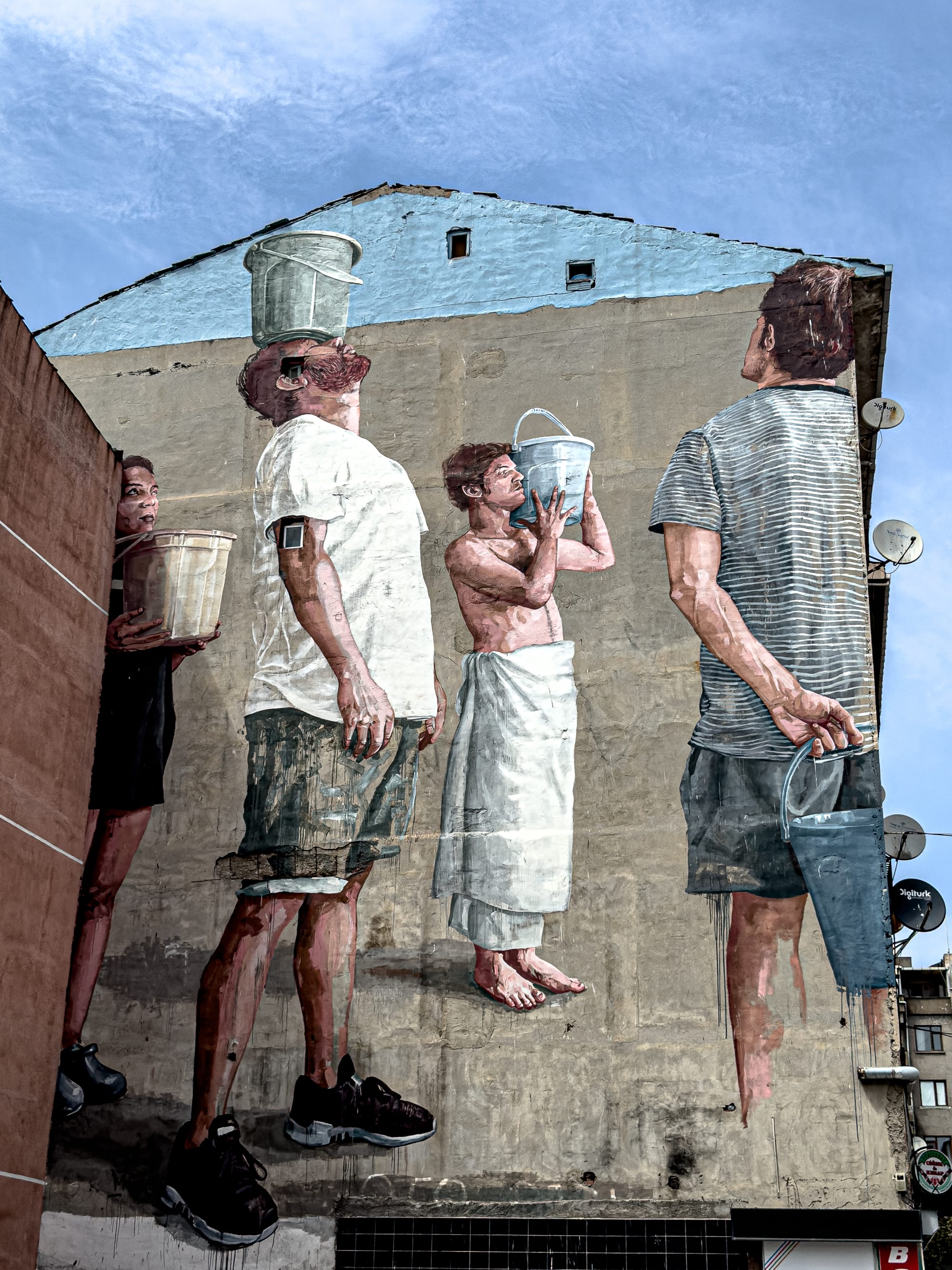
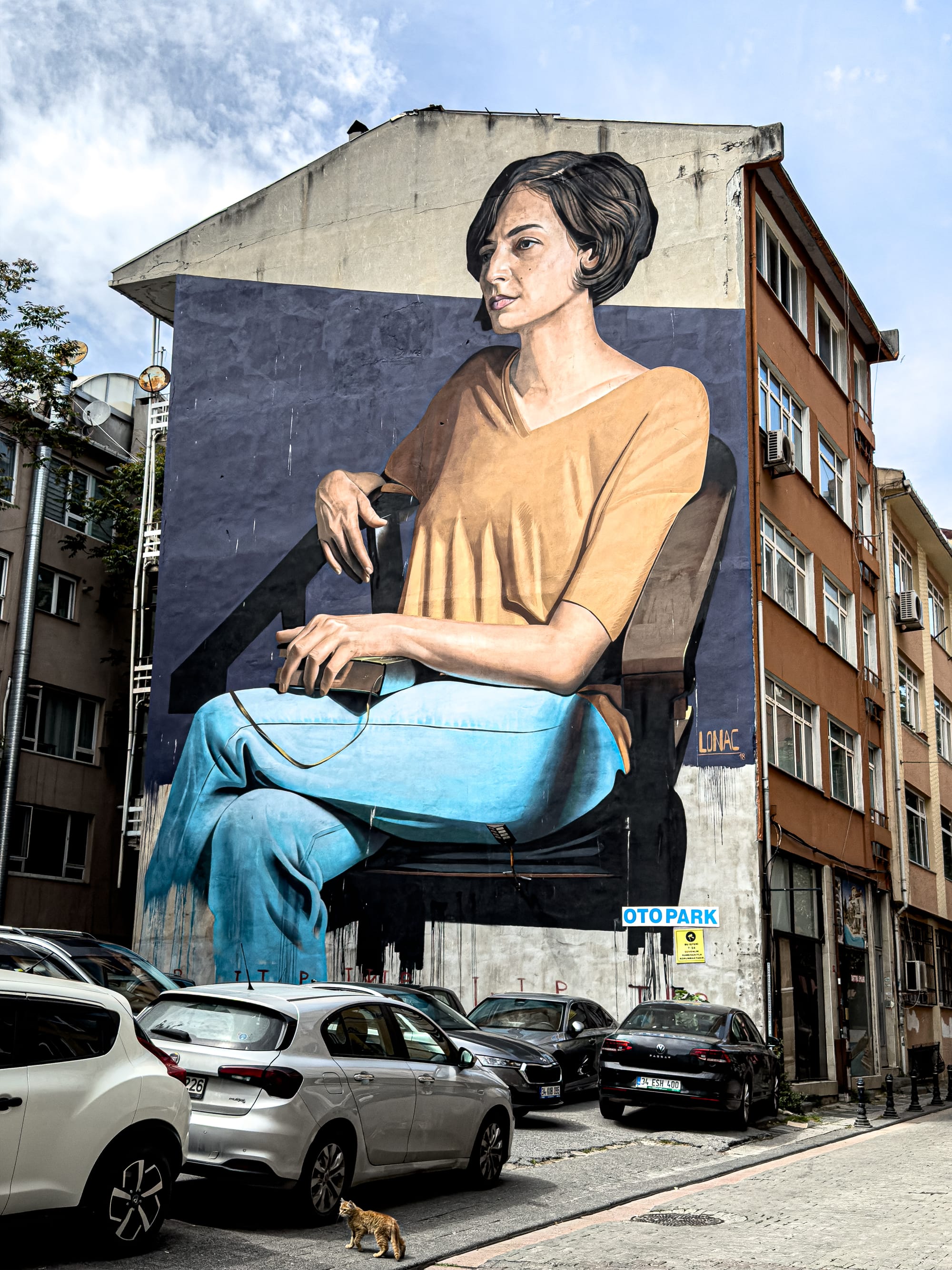
Murals by Fintan Magee and Lonac bring emotional realism to the streets of Kadıköy
You don’t need to hunt for it. A sticker here. A stencil there. A cat painted onto the corner of a cracked wall, half-faded but somehow more perfect for it. Even the layers of scribbled tags, protest slogans, and surreal symbols feel intentional—less like vandalism and more like a slow, collaborative reimagining of public space.
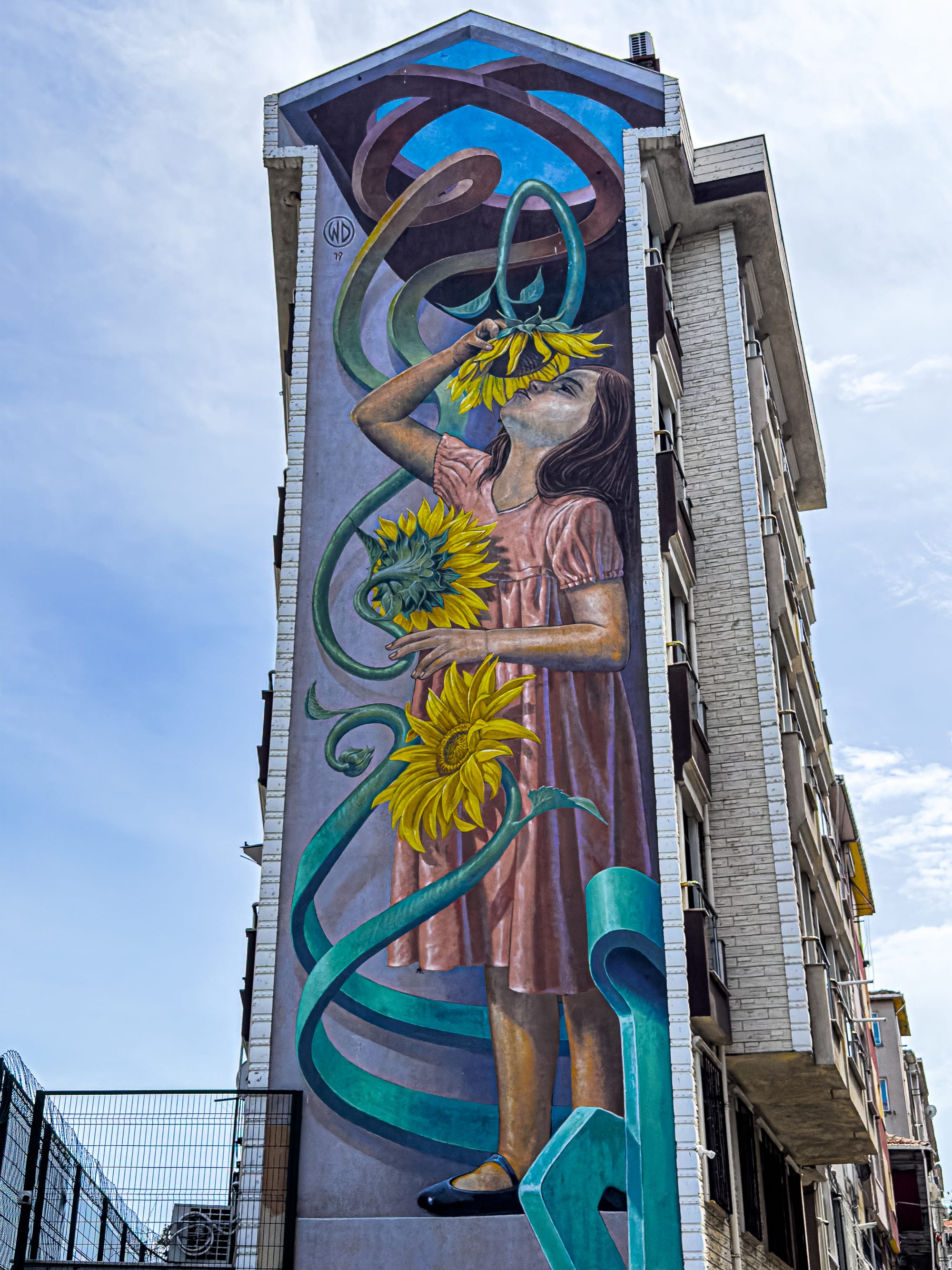
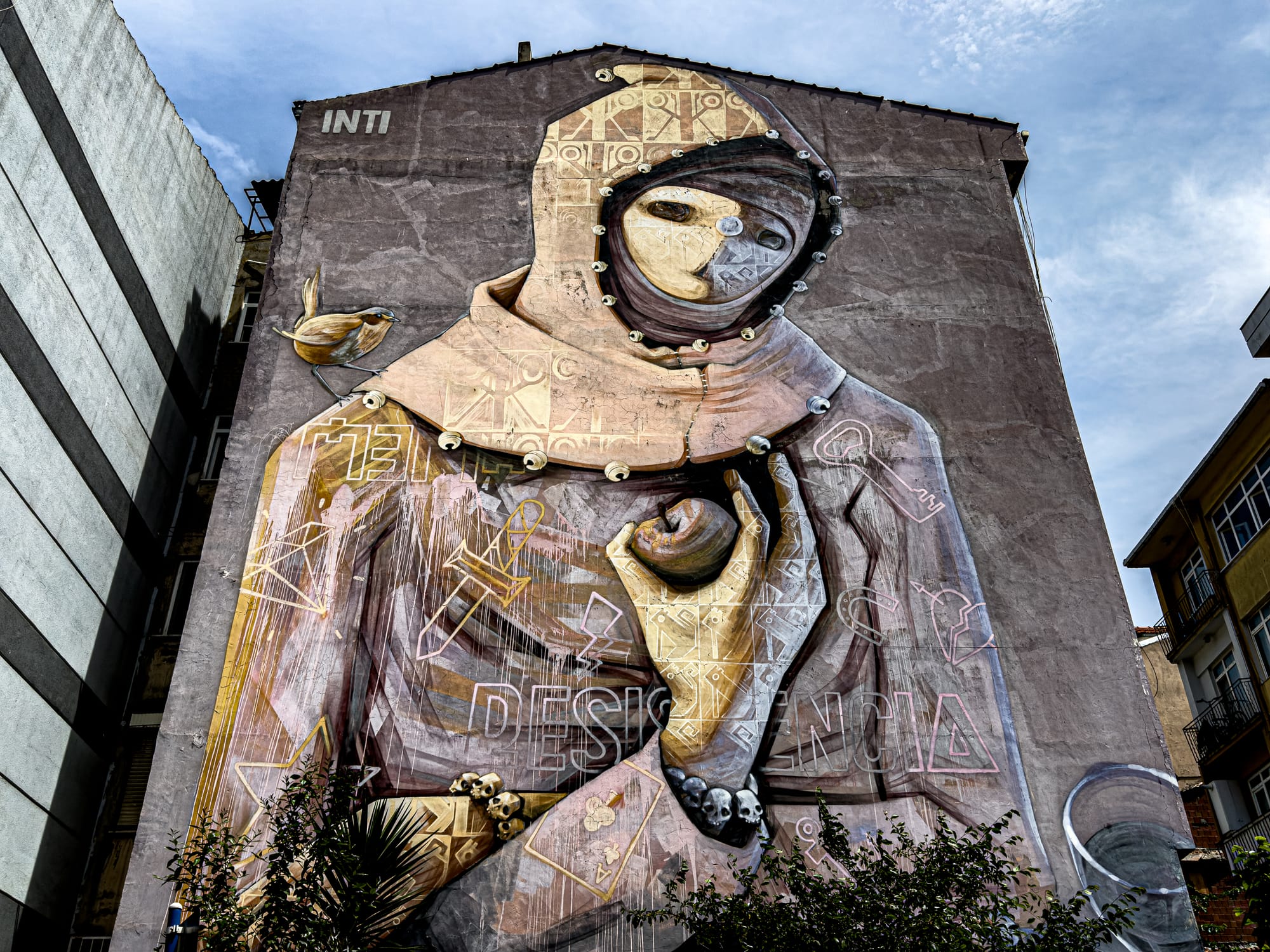
Two of Kadıköy’s most striking murals, one by WD and the other by INTI
Much of the mural work is monumental. Towering pieces by artists like INTI, Dome, Fintan Magee, Sepe & Chazme, WD, and Pixel Pancho turn blank buildings into full-scale canvases. You’ll round a corner and find yourself face to face with a blue-skinned mythological figure, or a dystopian cityscape unraveling from the sky. Some works speak to political resistance, others to climate change, migration, surveillance, memory, or dream. Some are just beautiful. Others ask more of you.
Grit + tenderness
Part of what makes Kadıköy so alive is that it resists polish. It doesn’t perform perfection for visitors. It doesn’t disguise its frayed edges. You’ll find visible poverty here—including a noticeable population of unhoused people, many of whom sleep in alleyways or collect recyclables from wheeled carts. Some storefronts are shuttered. Walls are cracked. Infrastructure is aging and uneven. The paint peels, the metal rusts, and the graffiti rarely gets scrubbed off.
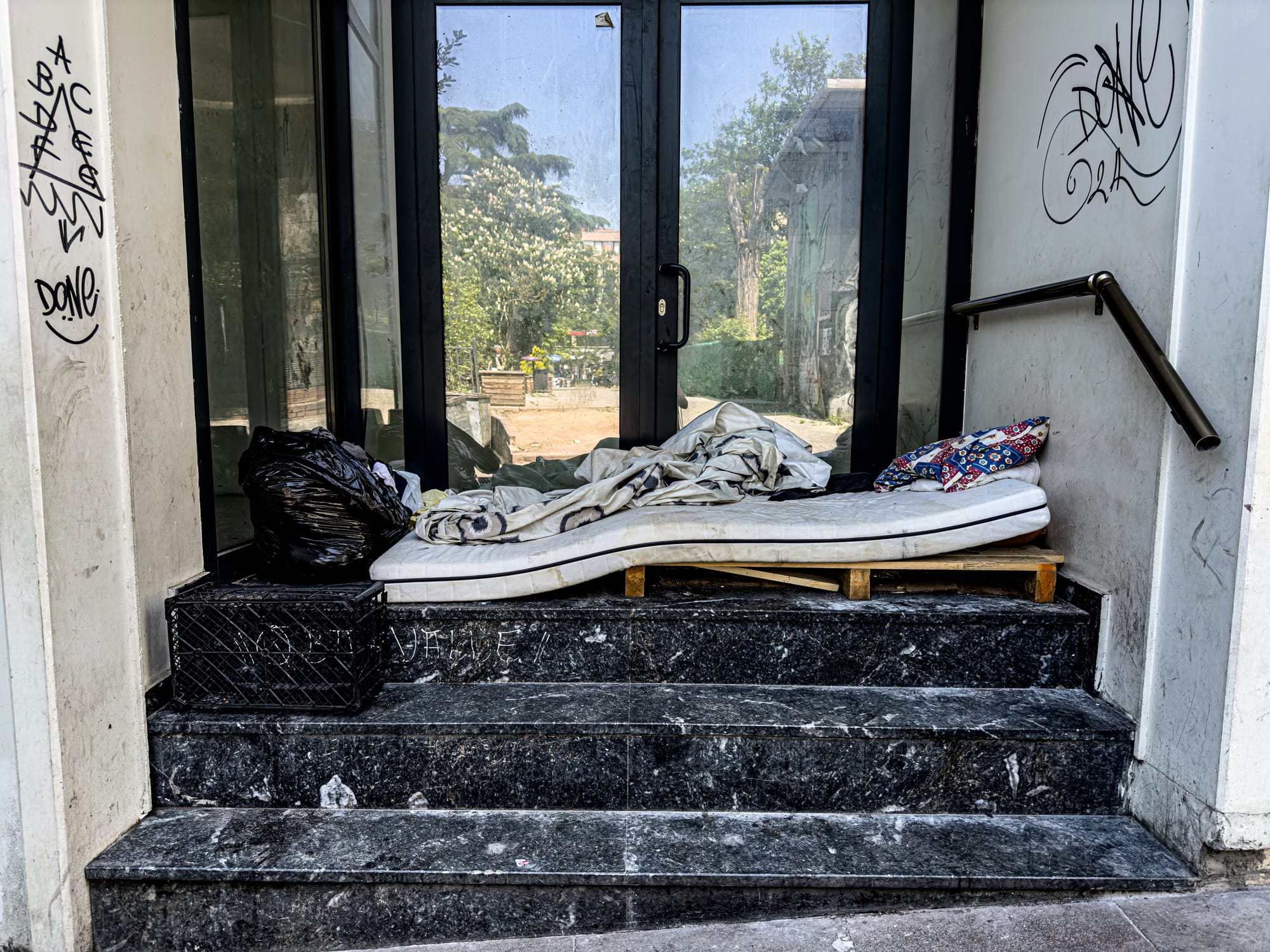
But none of that makes Kadıköy feel harsh.
Instead, there’s a kind of gritty tenderness that pulses through the neighborhood. People make do, and they make beauty while they’re at it. Graffiti doesn’t just scream, it mourns and jokes and remembers. Murals bloom on neglected facades. Plants grow from broken sidewalks. You’ll see someone carefully sweeping their stoop, or refilling a bowl of water for a street cat stretched out in a sunbeam. Markets spill over with color, flower vendors creating rainbows on the pavement. Someone’s taped a sketch to a wall. Someone else has tucked an old chair into a square of shade, just in case.
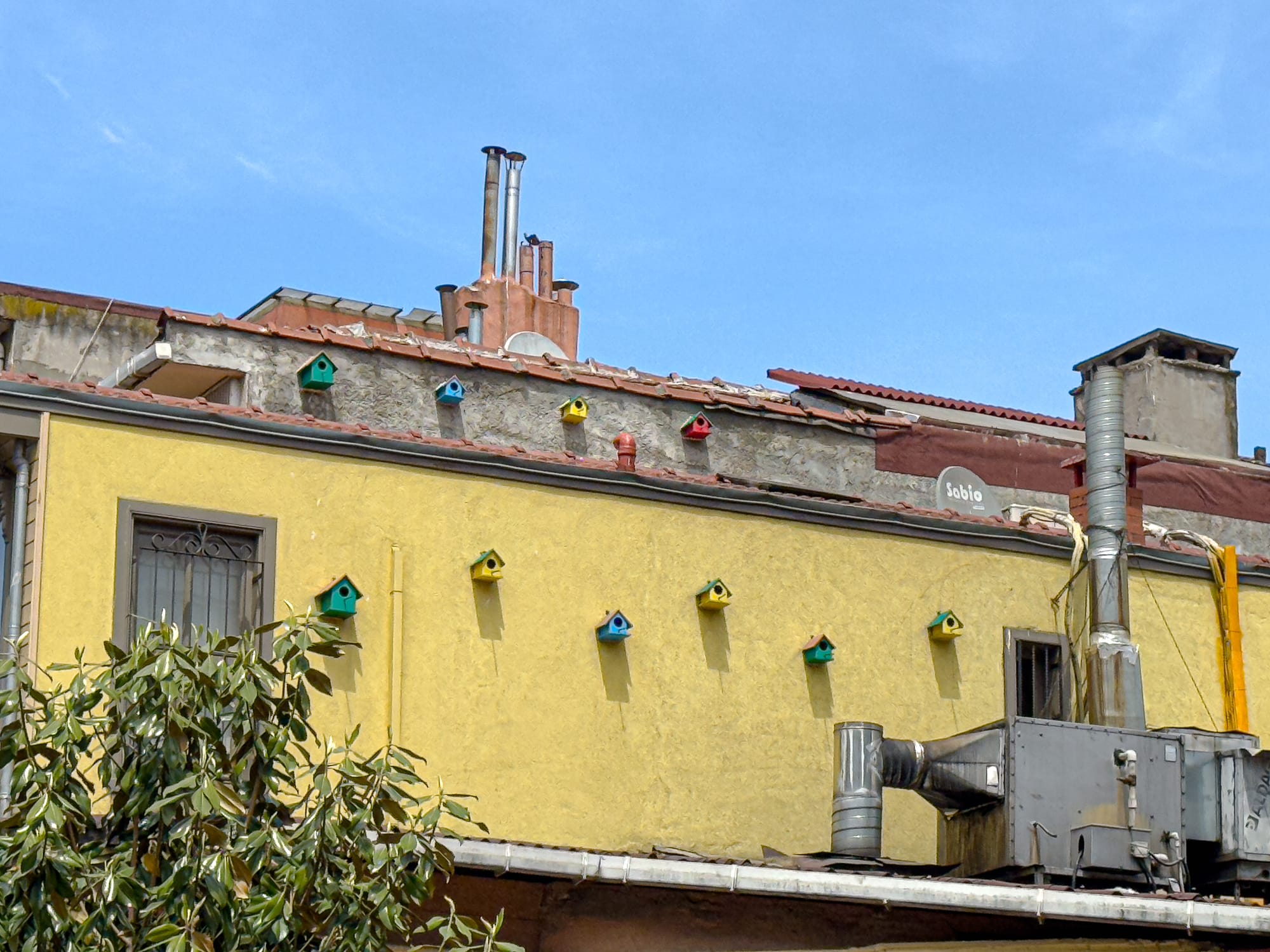
There’s a rawness here that feels more honest than bleak. The aesthetics of rebellion, repair, and reuse live side by side with signs of quiet care. It’s a place that hasn’t been sterilized or overly curated—yet it’s brimming with intentionality. From the rooftop gardens to the little shrines of stickers and street flyers, Kadıköy wears its collective vulnerability like a badge, not a scar.
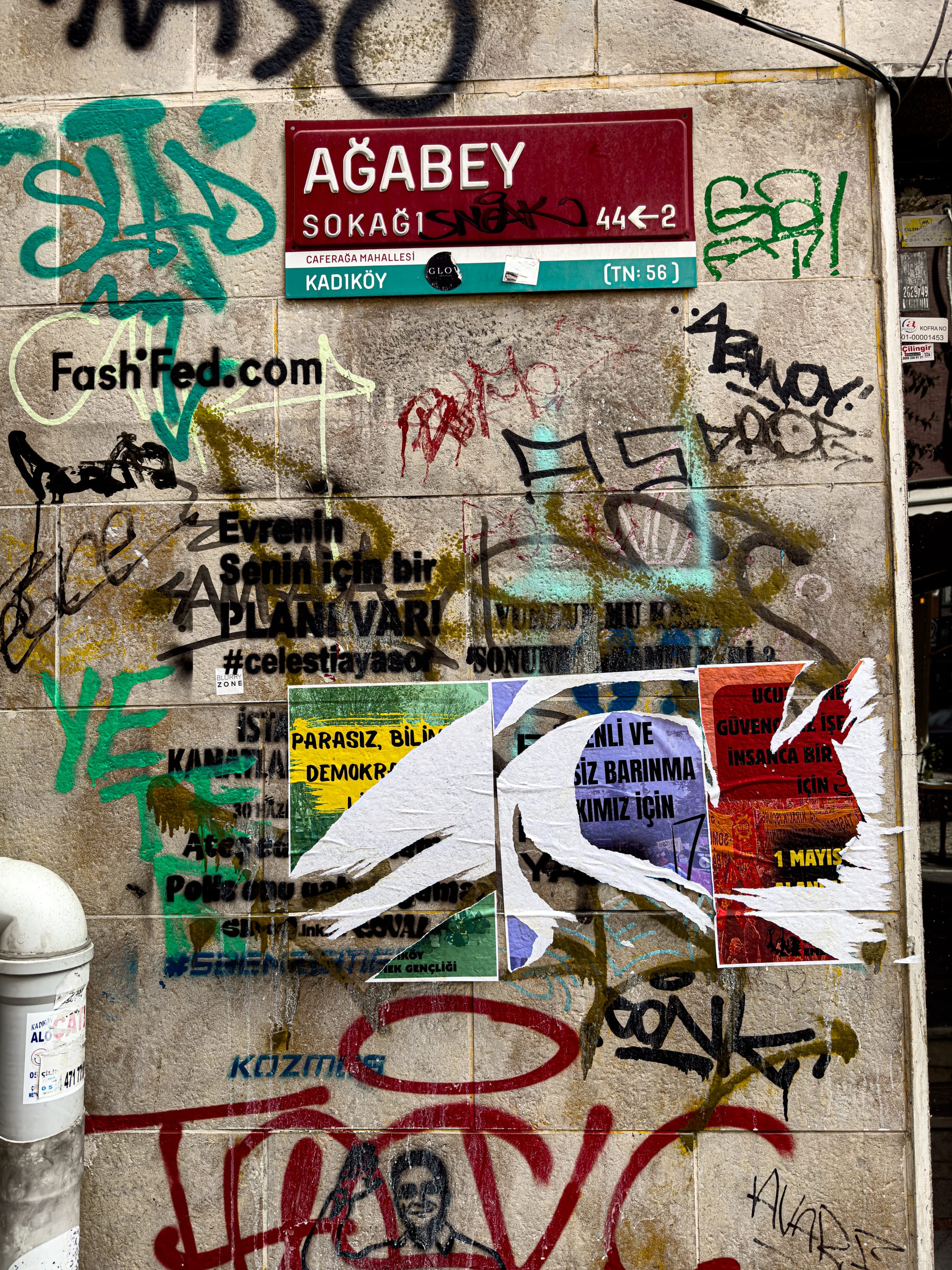
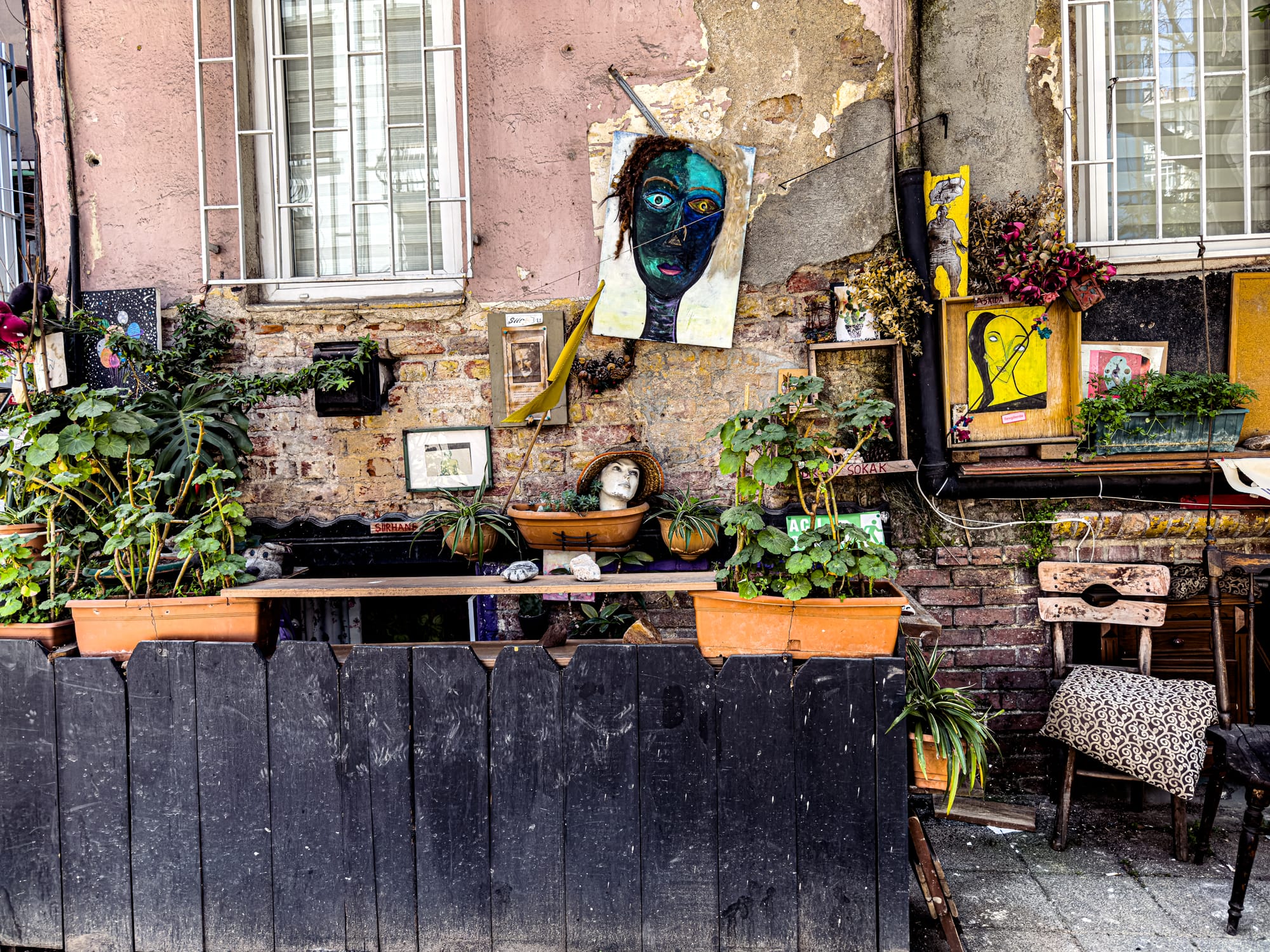
From tagged alleyways to impromptu art shrines, Kadıköy wears its politics and creativity out loud
You get the sense that this neighborhood has weathered things. And that the people who live here—artists, musicians, shopkeepers, elders, immigrants, students, cats—are holding it together not through control, but through a kind of informal mutuality.
Exploring Yeldeğirmeni
Tucked within Kadıköy’s broader expanse, Yeldeğirmeni feels like a neighborhood in motion—one where old rhythms and new gestures coexist in dynamic tension. Its name, which means windmill, hints at constant movement, and the area lives up to it.
Historically, Yeldeğirmeni was a working-class enclave shaped by railway workers, German engineers, and craftspeople who contributed to the early modernization of Istanbul. Walk its streets slowly and you’ll catch glimpses of arched windows, Art Nouveau flourishes, and hand-painted signage from another era—subtle reminders of a neighborhood built by many hands, layered over time.
In the past decade or so, Yeldeğirmeni has emerged as one of the most creative, independent-minded enclaves in the city. Where there were once workshops, there are now artist-run spaces, experimental cafes, secondhand bookshops, and studios filled with sunlight and sound. It’s not uncommon to stumble across a window glowing with sculpture or ceramics, or to hear a cello or jazz guitar drifting out from behind an open door. Musicians rehearse in subterranean studios, zines are printed on risographs, and murals seem to appear overnight—each one distinct in tone, yet collectively shaping the visual and emotional fabric of the area.
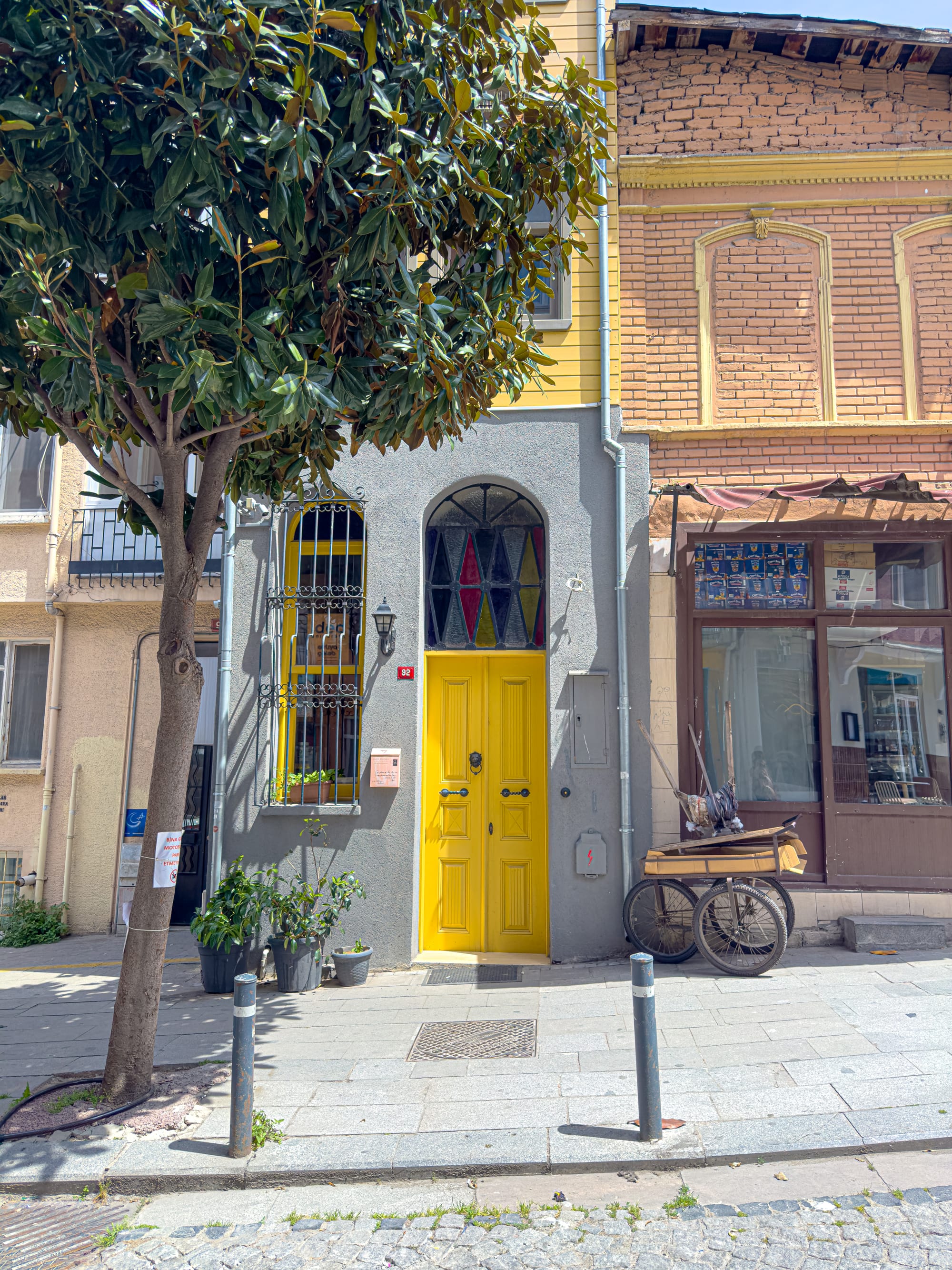
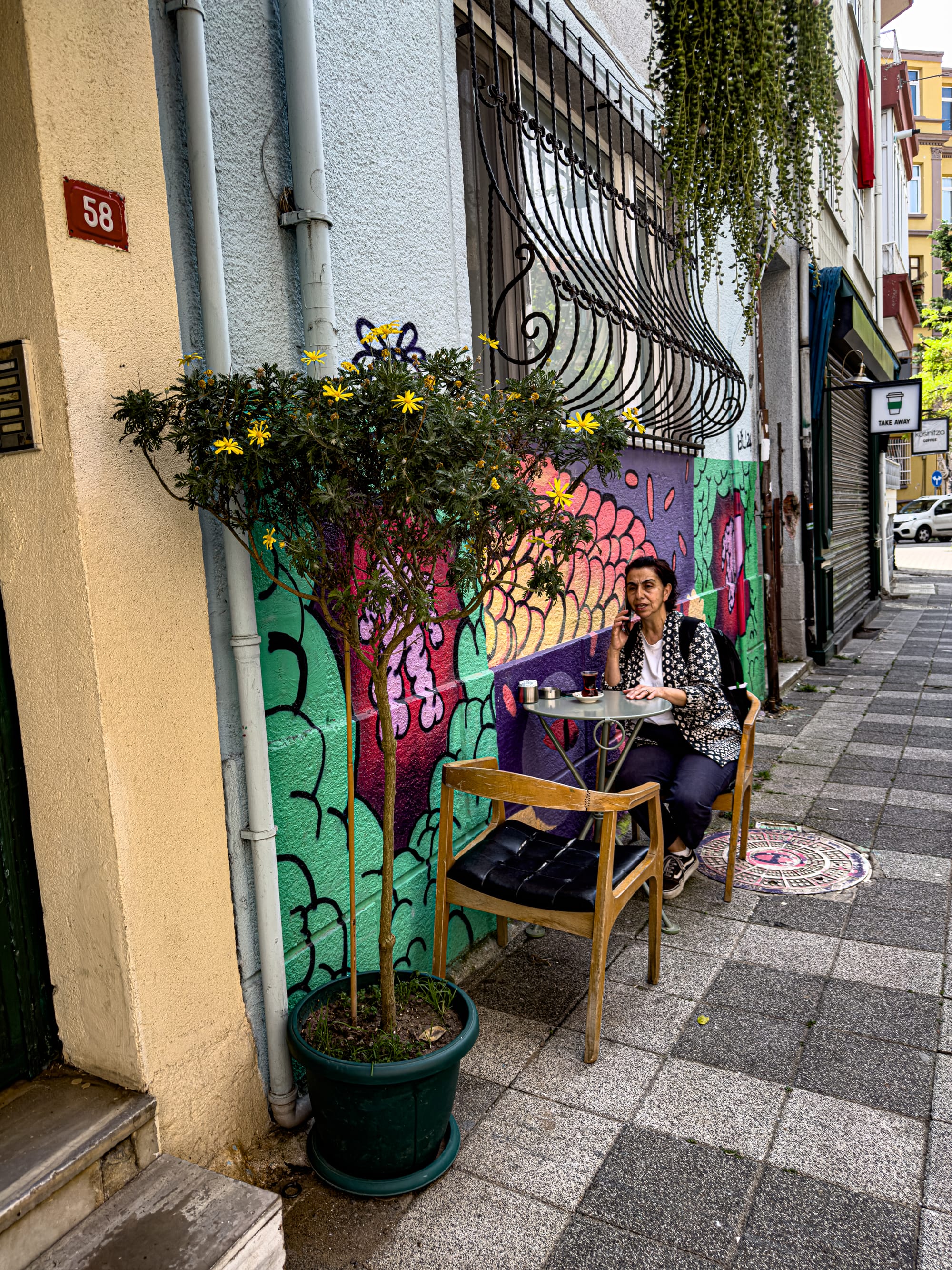
Bright yellow doors, colorful murals, and curbside çay—Kadıköy’s side streets are full of small delights
Yeldeğirmeni feels lived-in but not stagnant, scrappy but not careless. Some buildings are crumbling while others have been lovingly restored by their current residents, many of whom are artists, writers, and young professionals choosing the neighborhood for its affordability, character, and sense of possibility. The energy here isn’t manufactured for tourists—it comes from the people who are actually living, working, and experimenting inside it.
It’s also deeply walkable. Winding streets and sudden staircases reveal surprising vistas of the Marmara Sea or hidden squares covered in vines. Around one corner, you might find a cooperative gallery. Around another, a third-wave coffee shop that shares its space with a screen-printing studio. Murals wrap the buildings like soft graffiti-banners of permission—permission to make, to question, to claim space.
In many ways, Yeldeğirmeni is Kadıköy at its most tender and defiant: a neighborhood that hasn’t let go of its past, but isn’t afraid to remake itself—on its own terms.
Kadıköy’s political edge
Kadıköy doesn’t just pulse with creativity—it pulses with resistance. Unlike more touristic quarters of Istanbul, where political expression is often subdued or sanitized, Kadıköy wears its politics openly. The walls are papered with flyers for workers’ rights, gender equality, and climate action. Rainbow flags wave from balconies. Protest graffiti—from anti-fascist slogans to feminist messages—layers the streets with an unfiltered voice.
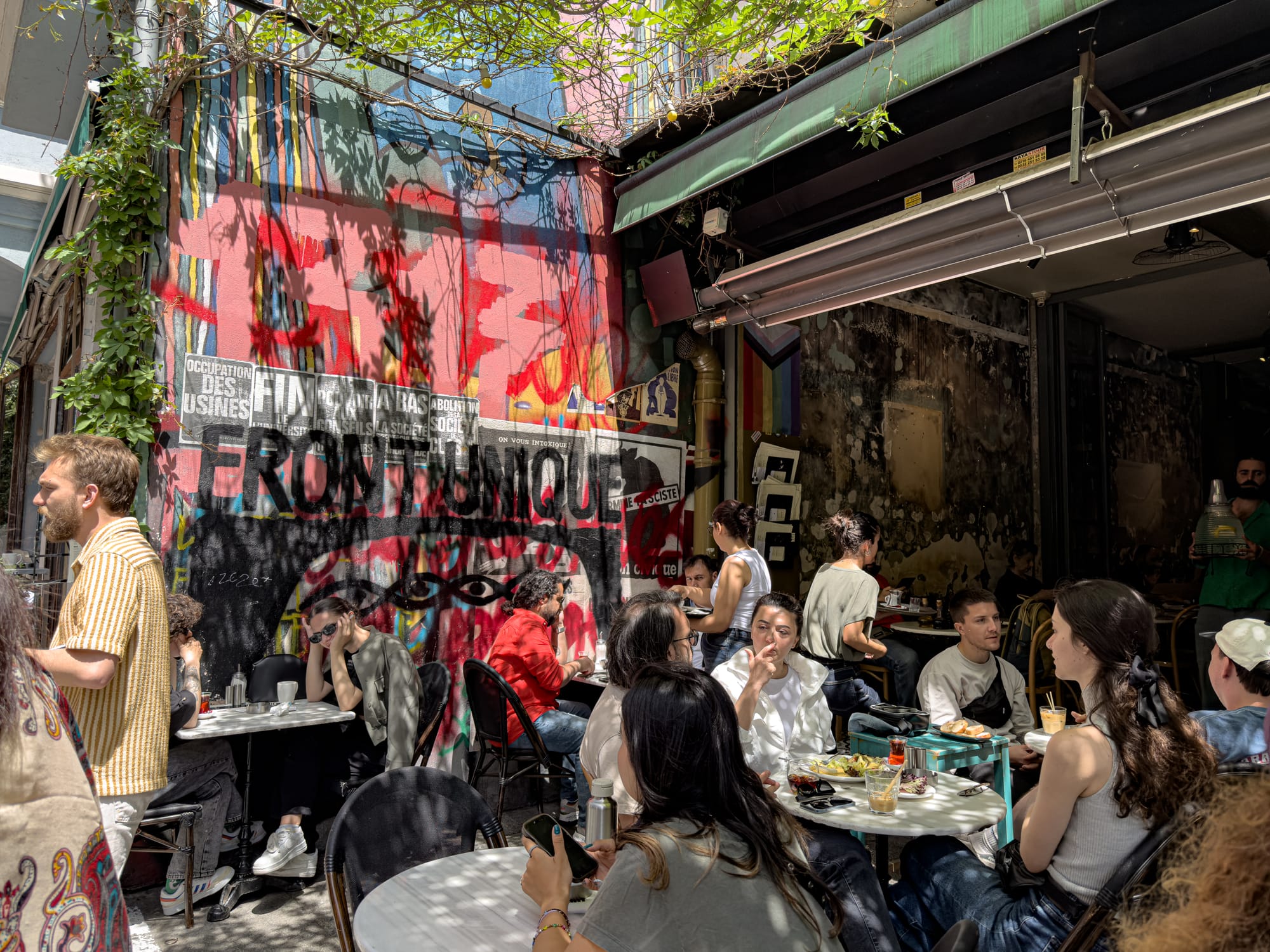
This district has long leaned left, both culturally and politically. It’s a known gathering site for demonstrations, often acting as a safe haven for political dissent. Labor unions march here. Pride events, despite broader restrictions elsewhere, find footing here. Feminist night walks begin in these streets. Even casual strolls through the neighborhood can become lessons in current Turkish movements—whether through street posters, pop-up lectures, or impromptu concerts for social causes.
For travelers who want to understand not just the Ottoman past or Byzantine grandeur but the living, urgent present of Turkey—Kadıköy is essential. It reminds you that Istanbul isn’t a city preserved in time. It’s a city still arguing, dreaming, demanding.
A haven for vegans
Kadıköy is hands-down one of the best neighborhoods in Istanbul for plant-based living. While traditional Turkish cuisine offers plenty of vegan-friendly mezes, Kadıköy goes far beyond the basics. You’ll find fully vegan restaurants, dedicated plant-based bakeries, and even a specialty vegan market—all tucked into the neighborhood’s maze of lively streets.
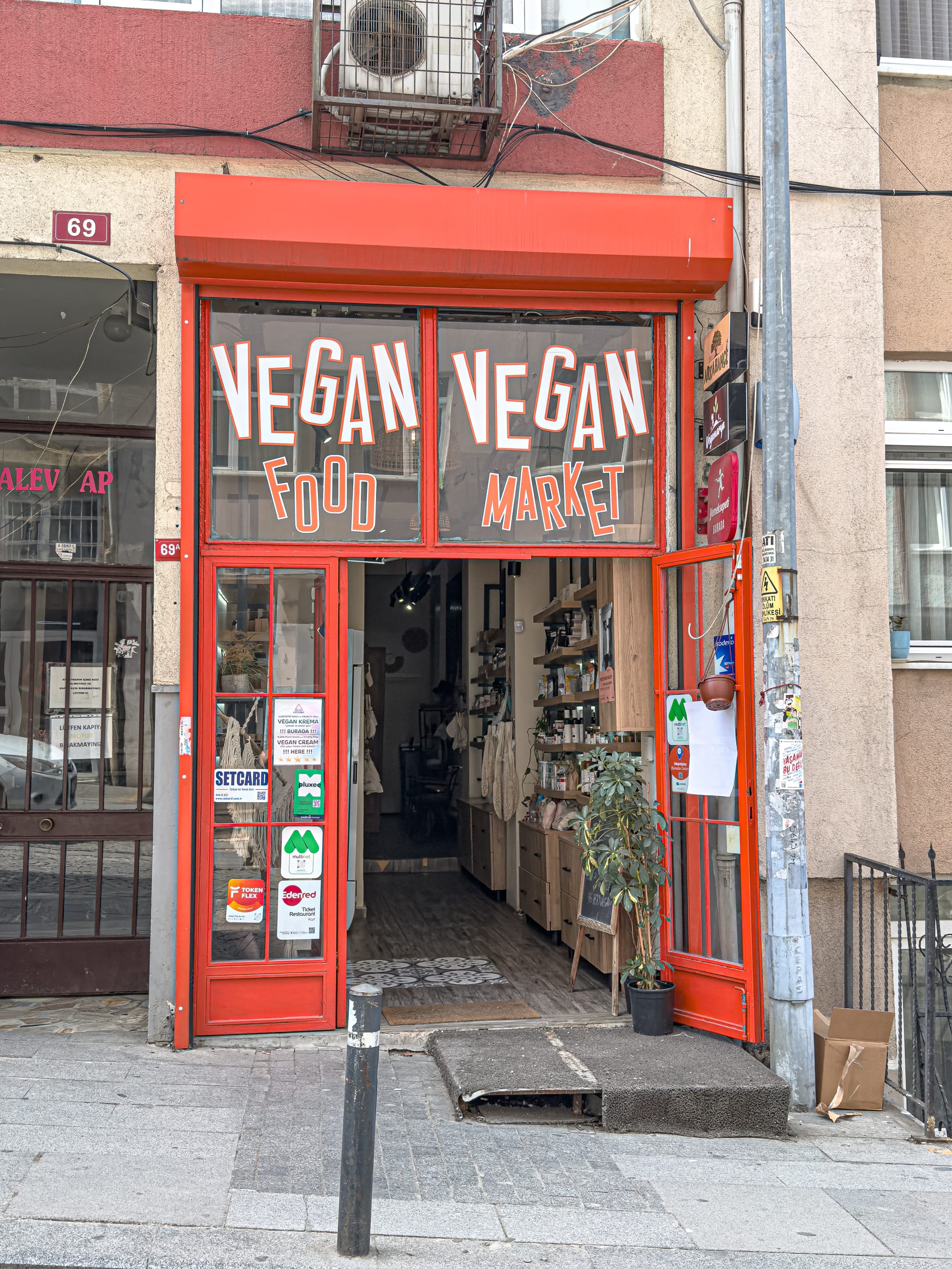
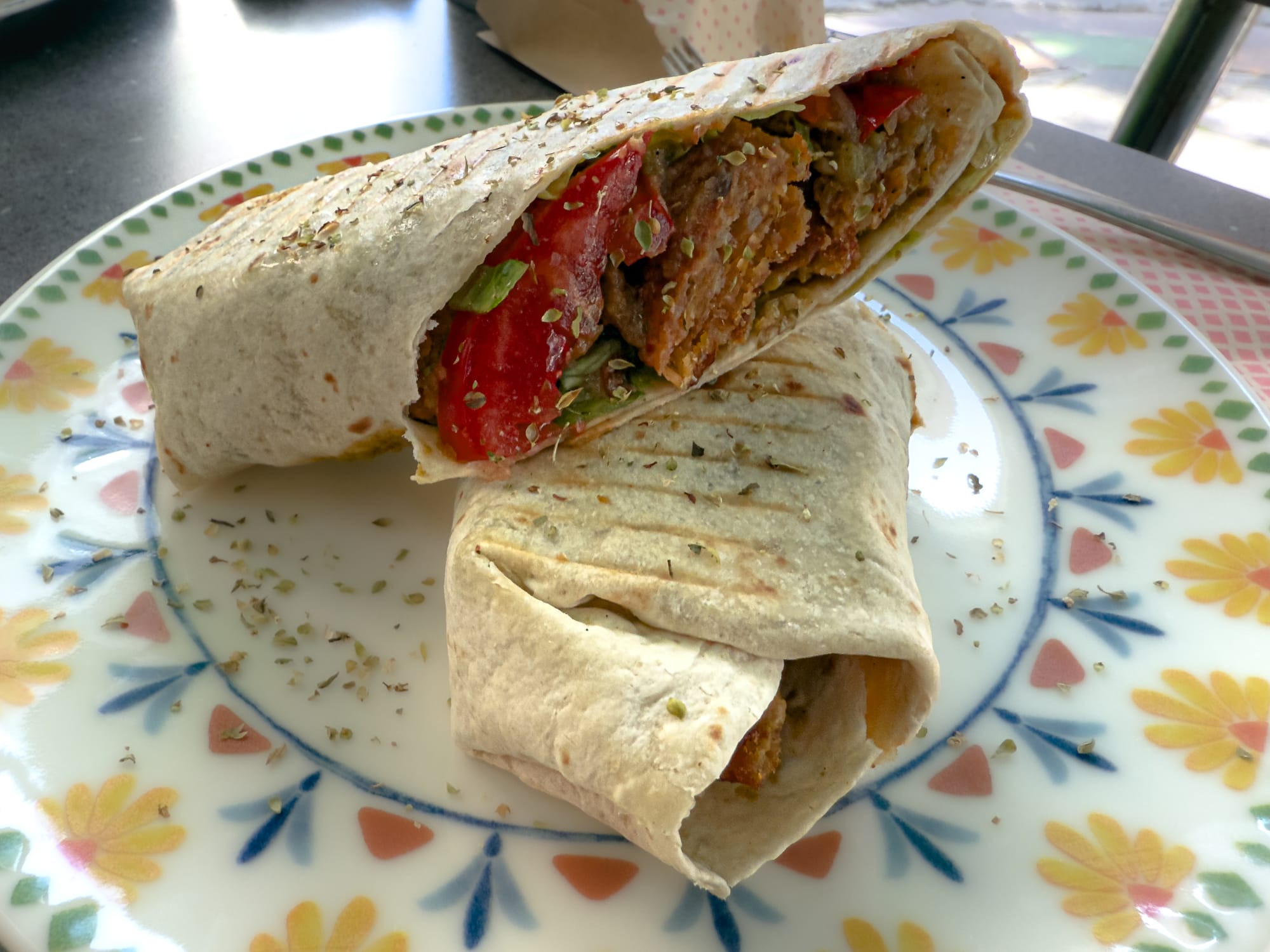
Kadıköy is a vegan dream: whether you’re stocking up on essentials at the Vegan Food Market or grabbing a wrap from Veganarsist
Our favorite stop was Veganarsist, a punky, flavorful spot that serves wraps, bowls, and desserts with a streetwise edge. But options don’t stop there. Kadıköy is home to a growing ecosystem of plant-based businesses, from cafés that offer cashew-based lattes to shops stocked with vegan cheeses, household items, and cruelty-free cosmetics.
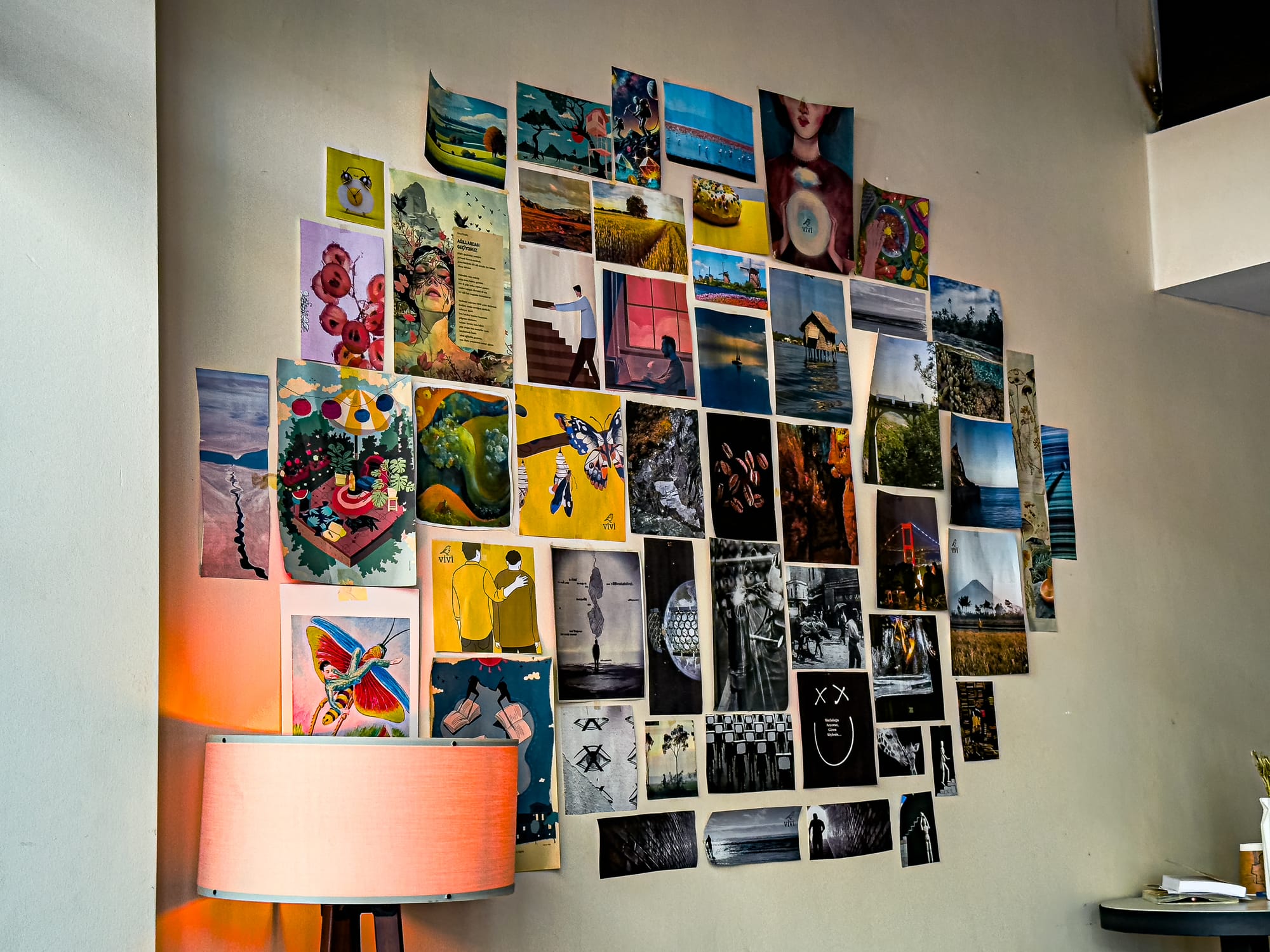
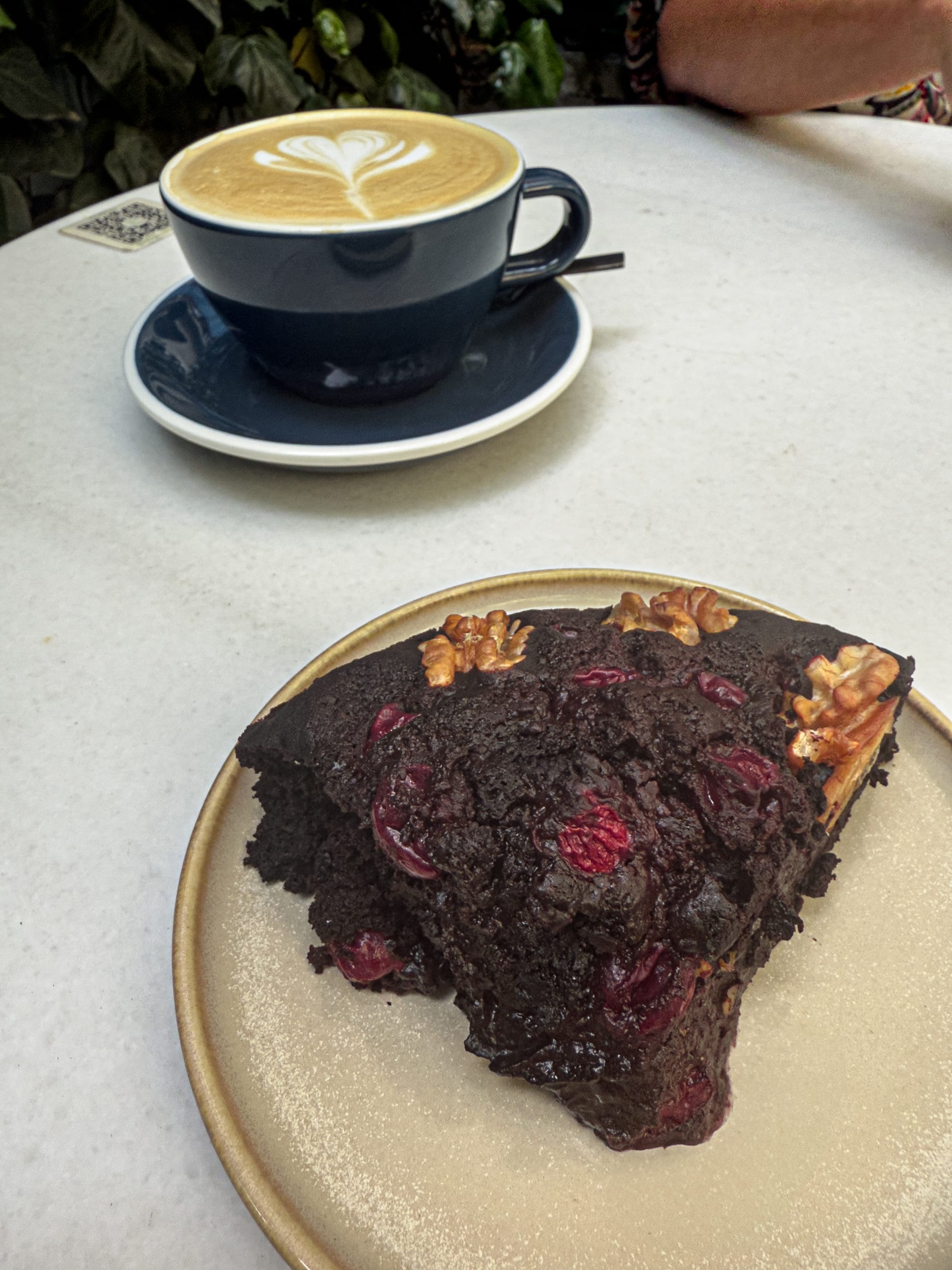
A vegan cherry-walnut brownie and oat latte make a quiet afternoon feel a little bit electric
This is the kind of neighborhood where being vegan doesn’t feel like a workaround—it feels like a lifestyle that’s actively supported. Whether you’re living here long-term or just passing through, Kadıköy makes it easy (and delicious) to eat with intention.
Why we love Kadıköy
Kadıköy doesn’t center itself around tourists, and that’s part of its appeal. It’s a place where daily life continues on its own terms—where neighbors chat over tea and murals fade into alleyways. It’s textured and busy, a little rough around the edges, but always full of energy.
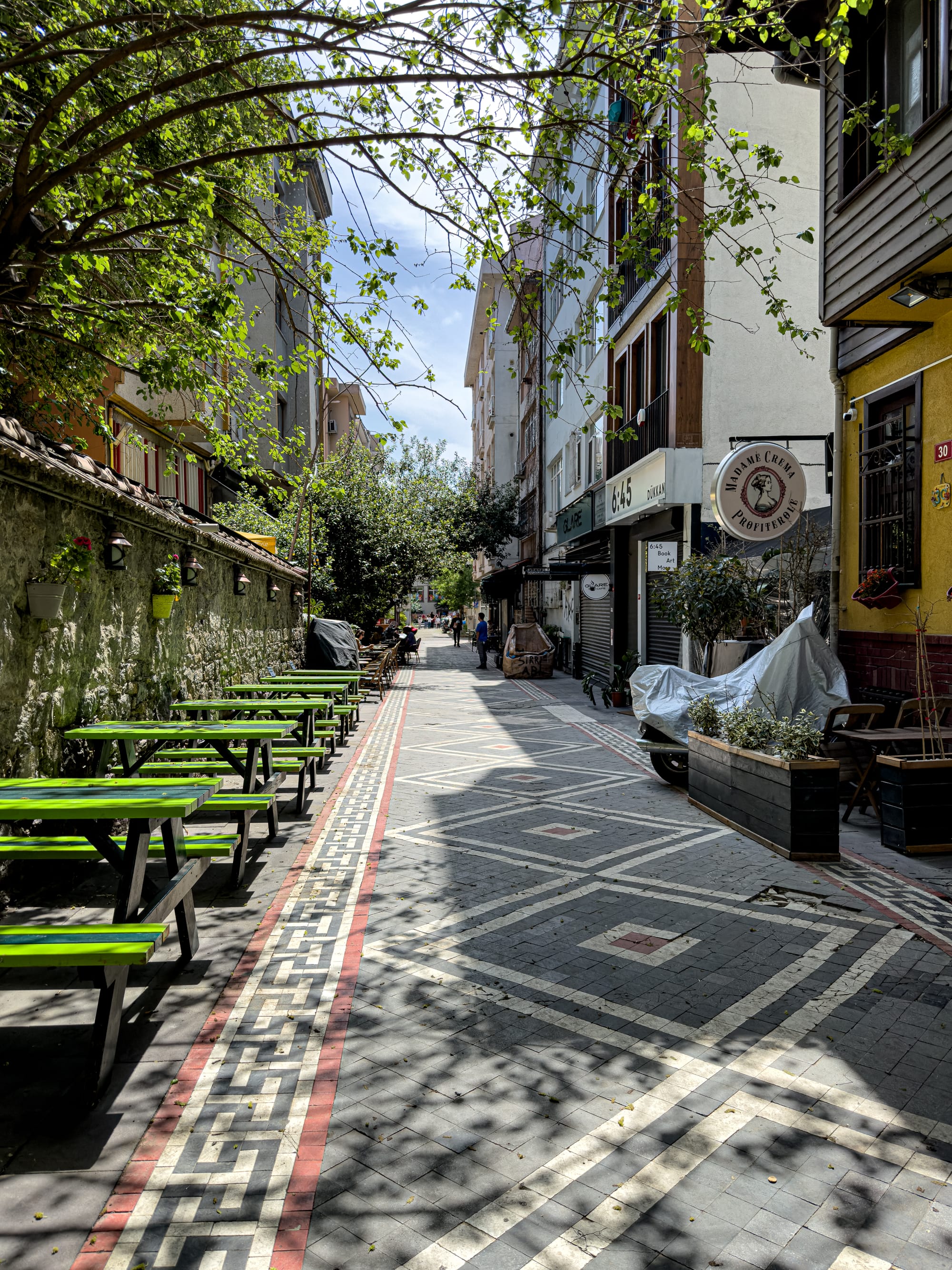
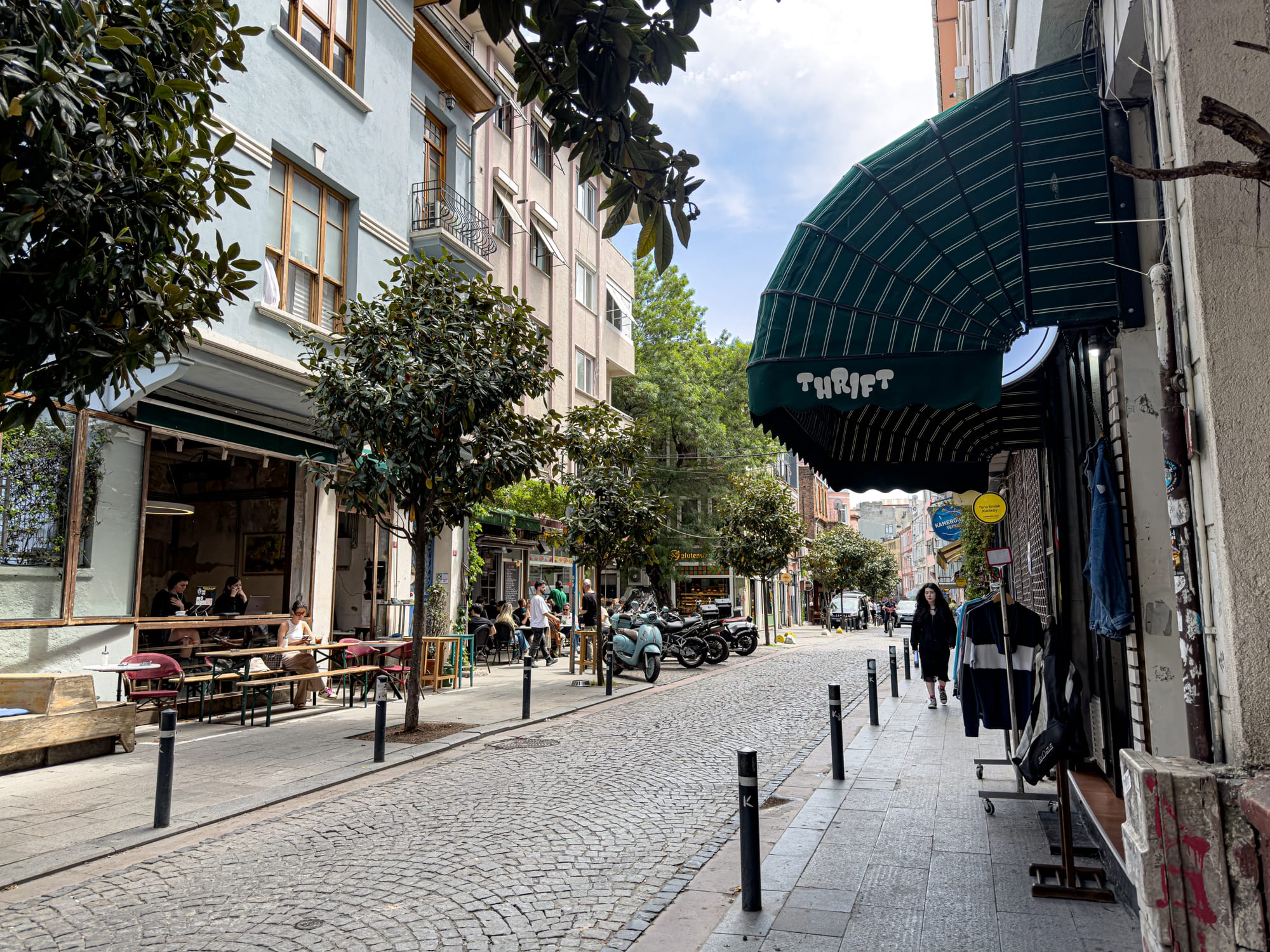
Kadıköy is made for wandering: leafy backstreets, tiled walkways, open-window cafés, and independent shops
For travelers and remote workers looking to experience a different side of Istanbul—one less curated, more lived-in—Kadıköy offers a solid base. Whether you’re staying a week or settling in longer, it’s the kind of place that makes space for routines: the café you keep returning to, the market stall that remembers your usual, the walk that clears your head.
While we didn't stay in the neighborhood ourselves, it would most certainly be our pick when returning to Istanbul.
Want a guided experience? This half-day walking tour introduces the neighborhood’s charm and also ventures to Uskudar.






